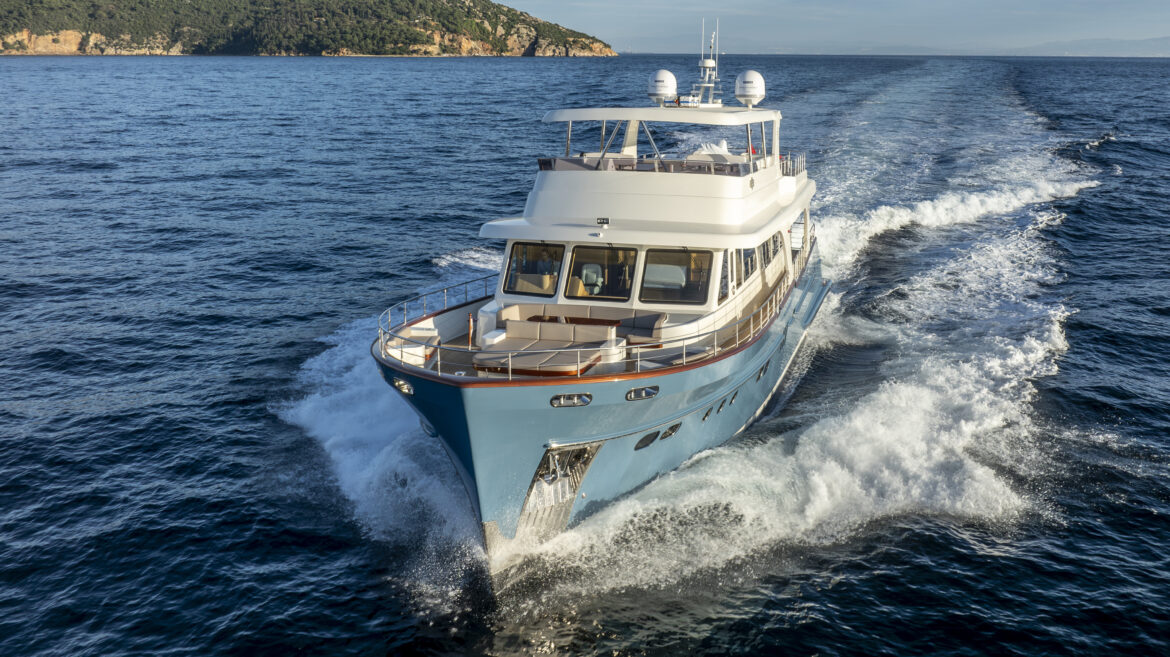TURKISH DELIGHT
Vicem is not a common brand in Asia Pacific but this latest custom-built 95-footer may very well change that.
The Turkish yard has a 33-year-long history of producing vessels based on a traditional approach to both build and aesthetics. In my travels as a yachting journalist, I’d most often see them at the Cannes and Genoa boat shows, usually standing out among the acres of other large yachts because of their more classic lines. Then, doing deliveries in the Adriatic, I’d often pass their forebears; the elegant, towering Turkish Gulets, usually sailing with the wind among the many islands. The wooden Gulets heavily influenced Vicem founder, Sebahattin Hafizoglu, and this tradition carries on in the cold-moulded Vicem 95.
So, seeing one in the flesh, as it were, after recently arriving in Australia was fascinating. Imported by experienced big boat dealer Leigh-Smith Yachts on the Gold Coast, the Vicem 95 makes a bold statement by simply being moored dockside during the Sanctuary Cove Boat Show; aided by the stylish International’s Awlgrip light blue (Stars & Stripes) finish. Another differentiator is the shapely hull that even has a faint touch of good old-fashioned tumblehome and a very practical rubbing strake near the waterline; handy for those rougher regions where coming alongside may necessitate fender boards.
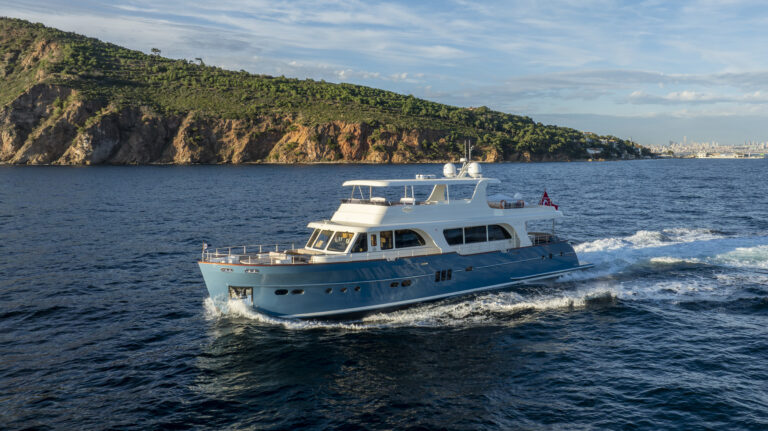
STRIKING AESTHETICS
As dealer Ryan Leigh-Smith explained to me during our walk-through, it was the striking aesthetics and traditional – read ‘seaworthy’- approach that attracted the Australian owners. Deciding to move up from a Grand Banks 72 to something with more range and liveability capabilities, yet still reflecting that classic era of builds, attracted these experienced boaters to the brand, which is part of the Turkish yard’s Classic Range with its flagship 107-foot model. “Their requirements were for an offshore capable vessel that was family friendly yet also could be chartered out,” explained Ryan. The three-year build required a lot of Australian input, including an owner’s representative and numerous visits from AMSA staff to ensure it could meet the standards (Cat 2C and IE). Named Empire, after the charter company that runs the vessel, it also allows prospective buyers of the brand to hire before buying. Empire is available for short and long-range crewed charters. This is facilitated by up to a 2,000 nm plus range at average cruising speeds; making destinations such as the Kimberly and the Pacific islands a reality.

STEPPING ABOARD
Stepping aboard is easily done, because of the vast swim platform – an owner’s requirement – that makes for an ideal water sports base because of the numerous chocks to hold dinghies and removable railings. For offshore, hoist them on the flybridge with the large davit. Adjoining the swim platform is the bulkhead door to the crew quarters. With lots of private and public space, these quarters were better than some superyachts I’ve recently been on.
Climbing up the stairs leads into the fully enclosed aft cockpit, an essential for our sunburnt climate, and in front of the cockpit are other stairs, leading to the flybridge which gives an easy flow to the Vicem 95 layout. The spacious area easily accommodates the large table and unlike a typical superyacht layout, the galley is nearby at the front of the saloon; rather than below decks, “Being primarily a family boat, the owners’ prefer this, and including any crew in their onboard life,” explained Ryan. Surrounding this cockpit area is a wide varnished and laminated taffrail, which covers all the topsides, clearly setting the tone for this gentleman’s motor yacht. Moving inside the wide saloon aft door reveals a light oak wood interior with lounge and galley forward with dinette adjoining. Vertical bulkheads and large surrounding windows combine with lightwood finish and mood lighting to create a contemporary, yet timeless ambience. Chatting to Ryan, I can easily gaze out at the sunny Queensland surroundings, while sunk comfortably into the couch.
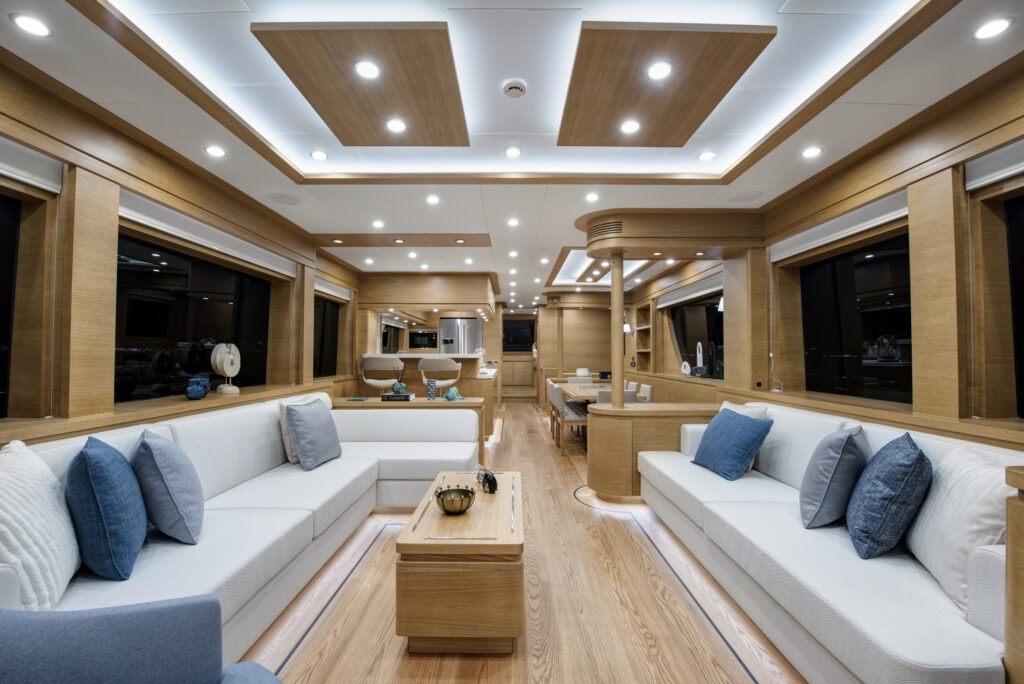
ARTISANS
Quality finishes include the beautifully rounded ends of all cupboards and protruding surfaces; clearly showing the hand-finished craftsmanship that reflects the Istanbul yard’s ethos. Walking along the wood-laid floor takes me to the U-shaped galley that feels fully integrated into the entire area. Here, the composite worktops can accommodate several family members contributing to the meal, aided by a four-ring Bosch convection cooktop and oven; with a huge double-door fridge and adjoining freezer space. Spectators are also welcome here, via the coffee bar and high chairs at the back of the galley. Other key white goods include the washer/dryer in the crew quarters.
The galley is ideally near the inside helm, with day head between, so the crew can switch between duties; or the owners can enjoy socialising when in passage mode. Here there are two bucket seats, so command need not be lonely and good practicalities such as sturdy doors on each side for easy communications with deck crew. The entire bridge is panelled in light oak which creates the warm ambience of a private yacht, rather than a commercial vessel. Essential navigation gear includes electronic throttles for the twin MTU 1600bhp shaft drives and fore and aft thruster controls. In addition, Steve the skipper told me he likes the MTU remote hand-held that can be plugged into various parts of the vessel for drama-free docking. Charting and radar are on Garmin 12-inch screens plus autopilot and satellite communications.
Another plus for the busy skipper is the nearby steps (on portside) up the flybridge, ensuring a weatherproof movement between decks. Probably the largest in this category, the truly vast flybridge is remarkable and a major specification from the Australian owners. But again, they chose function over purely form, by creating a dinghy dock with a powerful davit at the back. Yet, there’s plenty of room for entertaining in front of it, along with fine dining under the hardtop. Cocktail hour is well catered for by the large wet bar, U-shaped lounge and mahogany table while under bare feet is the comfort of thick teak cladding.
In front, the steering console is again on starboard and echoes the functionality of the below decks one. My only gripe is to possibly have it on port, so you cover both sides for berthing scenarios. Instruments are shaded by the hardtop and a visor reduces windage. Visibility is greatly enhanced with the slim (but strong) stainless struts all around that hold the hardtop, and minimise windage.
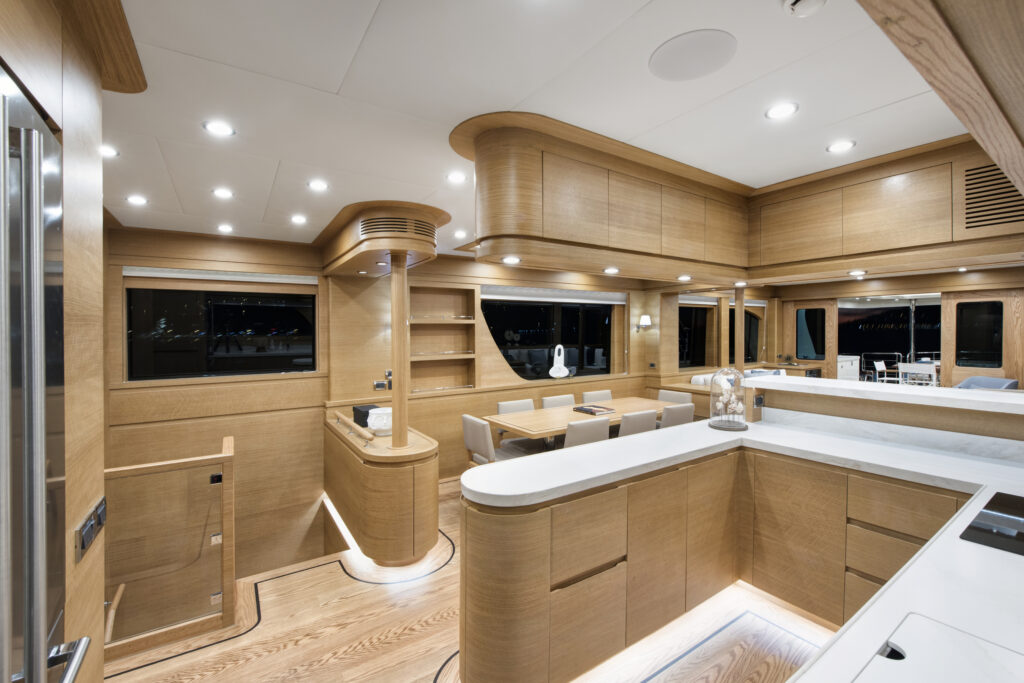
BEDTIME
The four-cabin layout in the voluminous 95-foot hull gives generous space to all occupants, with the midship owner’s suite the best place to sleep offshore. Here, I am low in the hull and looking out through elongated portholes avoids feelings of claustrophobia while the king-sized bed with sprung mattress makes sleep enjoyable. Behind, nicely cushioning any engine noise, are twin bathrooms with a large shower cubicle between. The single-level layout has tall headroom and generous lounge space in the side couches with storage discretely in under-bed cabinetry. ‘Unadorned’, was scribbled in my notepad at this point, reflecting a very Australian sensibility, rather than Euro-bling.
The guests aren’t slumming it either, especially the forepeak cabin, which has an island bed and again voluminous headroom. Surrounded by cupboard space and with wardrobes, it’s a comfy berth in port with a spacious ensuite that has natural ventilation. The sturdy portlights reflect naval architecture rather than onshore stylists, ensuring good seaworthiness in this critical part of the hull. Another safety feature is a skylight, for an emergency exit. Between the fore and aft cabins are the two other guests, with two singles in one plus pulman, while across the corridor is another queen-sized double with ensuite.
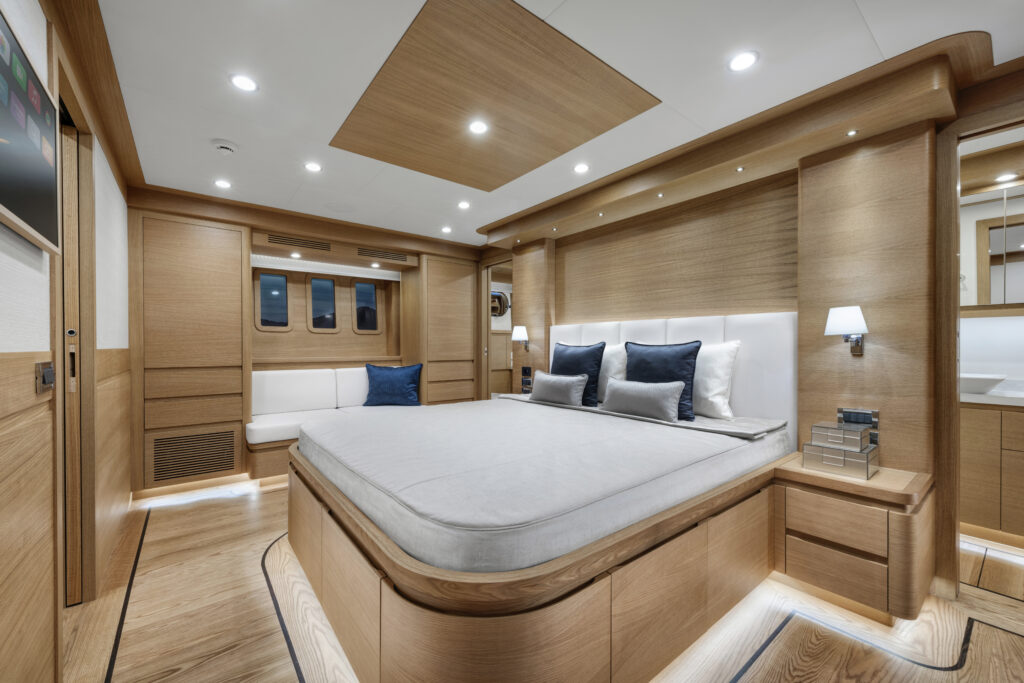
SHADE AND LIGHT
Deck space for an Australian yacht has to be a mix of shade and light, thus the oversized hydraulic swim platform and the spacious foredeck lounge give sunlight; while the aft deck and flybridge offer good shade. In between, during my walk-through, I’m protected by high bulwarks and overhangs like you find on most trawler-style yachts. Underfoot, thick teak cladding ensures grip and comfort for bare feet before you relax on the twin sunbeds for some bow riding or lazy anchor days. And you can rest easy because the rode setup is more than adequate with twin vertical Australian Muir VRC4500 windlasses and deep anchor lockers. Going alongside is done via Muir capstans, wide fairleads and huge cleating to minimise any dramas.
COLD MOULDED HULL
In the 1980’s Turkish businessman, Sebahattin Hafizoglu developed a passionate regard for the historical schooners of the Bosporus, the Turkish Gulets. These traditionally used lateen sails for propulsion but also use large diesel nowadays when they operate as charter boats and cargo boats. Hafizoglu decided to reinterpret them for modern sensibilities, using state-of-the-art cold moulded wood and epoxy techniques and founded Vicem in 1991. Business gurus call this seeking a ‘market differentiator’ but it was a clever way of harnessing artisan skills while using modern methods. So, the hull of the Vicem 95 has four cross-ply layers of mahogany plywood that are impregnated using the industry standard West Resin System with special reinforcing and a collision bulkhead at the bow, encased in a thick stainless sheath. Looking around the hull insides, showed me a smooth finish with stringers and frames every 0.6m, creating a rigid hull; yet one that is much quieter and arguably more sea-kindly than other materials. However, the adaptable yard can build in GRP or even steel, should the owner require it. Overall, the Vicem 95 is an impressive custom vessel that is Turkish-made but in many ways typically Australian really, being understated rather than ostentatious; yet with solid functionality and flare.
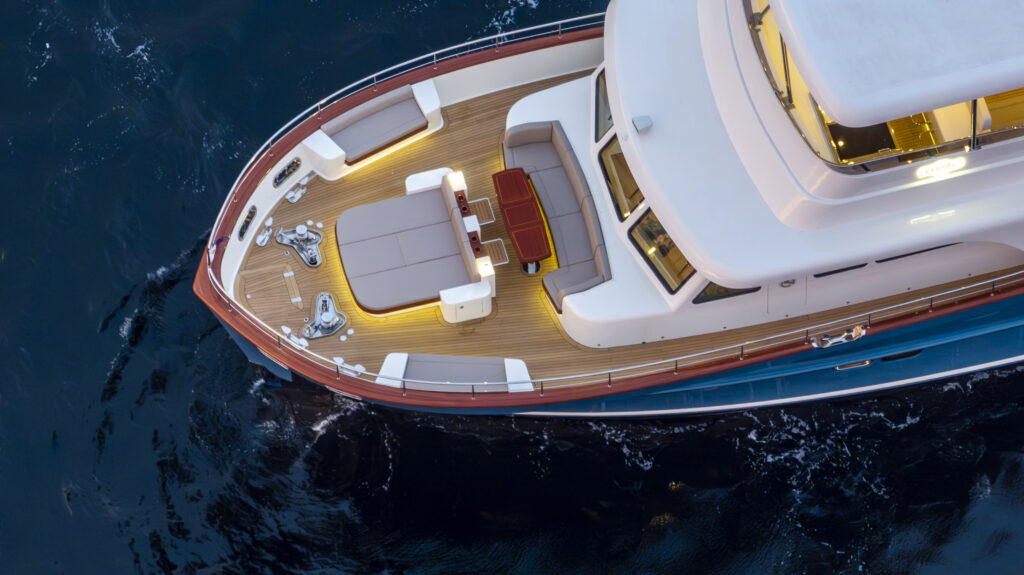
SYSTEMS
A vessel of this size naturally has a lot of systems and usually a professional crew along with specialist technicians to run it. This is largely true for the Vicem 95, yet it is mostly a fairly basic design, such as traditional wiring (rather than digital buses) with some key modern features. Like the intelligent Humphree vertical stabilisers. I’ve used these on other brands, such as Fleming, and they operate within the beam of the vessel but act like a kind of rudder system to stabilise – both at rest and at anchor. The engine room is reached via a massive bulkhead door in the crew quarters. Dominated by the Onan 27 kva generator set in the middle and MTU 10-cylinder common rail, sequentially turbocharged diesels on each side. Having worked briefly as a big yacht engineer, I know the feeling of being stuck in engine rooms, so I always seek out the ventilation and fireproofing systems. Both were more than adequate on the V95, as were the deep bilges to cope with any water ingress. The fuel system includes six baffled tanks to manage the 16,277 l load and a polishing system to deal with varying qualities taken aboard during foreign voyages. Sensibly, sight gauges are used in addition to electric readouts. Other equipment includes a large capacity Stella Aquarius (240 l/phr) watermaker and Dometic 720,000 BTU aircon units.
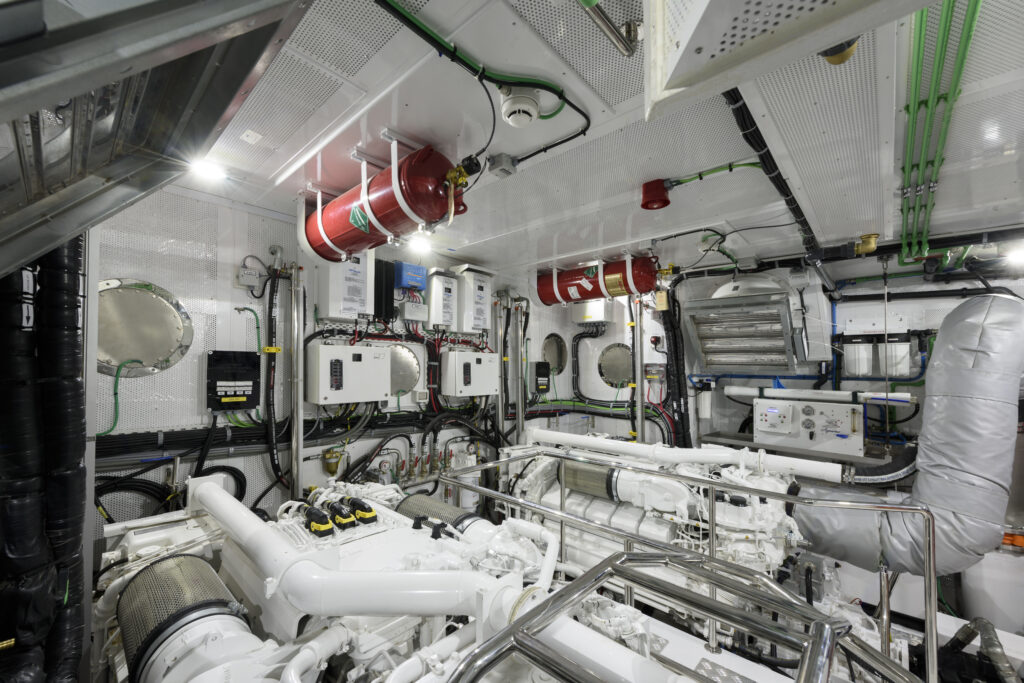
SPECIFICATIONS
Price POA
Length 96′ 4” – 29.3 m
Beam 23′ 0” – 7.60 m
Draft 5′ 7” – 1.70 m
Displacement 121,984 metric tons
Max. Persons Capacity 12
Engines 2 x MTU 10V 2000 M96L 1600 bhp @ 2450 rpm
Fuel 4300 gals – 16,277L
Water 550 gals – 2080L
Maximum Speed (knots): 8.2 – 19
Cruising Speed (knots): 9.2 – 13.3
Construction Cold moulded mahogany, West System Epoxy
PERFORMANCE DATA
RPM KNOTS L/h L/nm
1000 8.5 46 3007
1300 10.2 90 1845
1500 11 160 1119
1700 12.6 234 876
2000 14.7 356 672
2450 18.2 570 520


